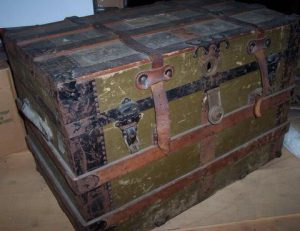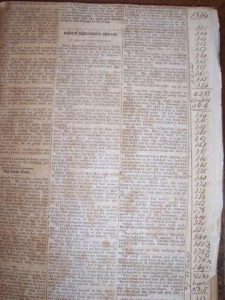 Facts can be so unsatisfying. Colorless (but critical) records of lives, people, places, and events, when facts are viewed in the context of heirlooms, memorabilia, or artifacts, things left behind by our ancestors, our past is better illuminated and gives us insight into older generations, providing a foundation for family stories. Readers of my posts on Vita Brevis will recognize my pursuit of and passion for those stories. Whether the facts give rise to the stories, or whether the stories begin by seeking the underlying facts, is something of a chicken-or-the-egg question, a fractal of genealogical research, repeating and replicating patterns of family interactions and history.
Facts can be so unsatisfying. Colorless (but critical) records of lives, people, places, and events, when facts are viewed in the context of heirlooms, memorabilia, or artifacts, things left behind by our ancestors, our past is better illuminated and gives us insight into older generations, providing a foundation for family stories. Readers of my posts on Vita Brevis will recognize my pursuit of and passion for those stories. Whether the facts give rise to the stories, or whether the stories begin by seeking the underlying facts, is something of a chicken-or-the-egg question, a fractal of genealogical research, repeating and replicating patterns of family interactions and history.
In Book of Ages: The Life and Opinions of Jane Franklin, Jill Lepore notes that what remains of anyone’s life is what’s kept. We leave things behind, but someone else decides what to keep. The past defines us (even if we don’t remember it!), but it’s what is kept that gives us definition and fodder for the stories we love to find. So what am I to think about the box I found full of old hearing aids, broken wire-rimmed, round-lensed eyeglasses, and an old set of dentures? (Seriously, people! Dentures?!)
Each of us at some point may be charged with the disposition of what’s left behind. How do we decide what is heirloom, memorabilia, fascinating, or just trash? For those of us who value history and all its trappings, nothing much is trash. For those who don’t agree, it may all be trash. I think there are four factors which determine what is kept: geographical, generational, functionality, and sentimentality (or the lack thereof).
When my husband’s California stepmother passed away, we of Maine were faced with the impossibility of shipping anywhere her 10-ton solid oak dining table, sideboard, chairs, and hutch that would stop armor-piercing artillery shells. She and her mother treasured them, but we lacked the familial contacts to share that feeling or to appreciate the functionality of that enormous set. The entertaining style of her generation exceeded in scope and tableware anything we could handle. Instead, we found a consignment shop owner with a big truck.
 Whenever I dive into my “squirrel bins” of family “leavings,” I’m astonished at what was kept as well as what wasn’t! There is a notable lack of letters, diaries, and manuscripts, any of which would enlighten me considerably as to the personalities of the writers. I do, however, have albums of snapshots (unmarked) and old greeting cards and postcards; a ledger apparently from an 1860s business, the pages of which have been pasted over with undated newspaper clippings; an 1880s home medical manual in case I want to check on the causes of blindness (don’t even think about asking!), and the above-mentioned box of personal items, including bits of someone’s corset.
Whenever I dive into my “squirrel bins” of family “leavings,” I’m astonished at what was kept as well as what wasn’t! There is a notable lack of letters, diaries, and manuscripts, any of which would enlighten me considerably as to the personalities of the writers. I do, however, have albums of snapshots (unmarked) and old greeting cards and postcards; a ledger apparently from an 1860s business, the pages of which have been pasted over with undated newspaper clippings; an 1880s home medical manual in case I want to check on the causes of blindness (don’t even think about asking!), and the above-mentioned box of personal items, including bits of someone’s corset.
I have to wonder why these things were kept (or to put it another way, what were those people thinking?!). While my family adhered to the adage “use it up, wear it out, make it do or do without,” I sincerely hope that didn’t extend to reusing old dentures! I understand why someone would keep a mother’s wedding gown, but a great-grandmother’s wedding gown and matching shoes may have no sentimentality left for descendants two generations removed, two states away, and who would find it severely lacking in practical function. I have my maternal great-grandmother’s huge trunk (empty, of course) that she took “around the horn” on her move from Maine to Eureka, California, in the 1870s. Because of its size, it may not move with me, nor will following generations understand its heritage, recognize the woman who owned it, or find any realistic function in it.
[Put] it another way, what were those people thinking?!
What’s left behind is not the same as what’s kept. What we have, what we find, and what we keep as family historians are important to those historians who come after us, especially if we ourselves want to define our past. I’d like to think that we do a better job now of marking, labeling, identifying, and storing what we decide to leave behind, as well as selecting a person who can be trusted to follow our final instructions; or perhaps we just have to leave better intentions. What’s kept is the history that will define us when it’s our turn to leave things behind.
I plan to leave behind my collection of murder mysteries and cookbooks with a copy of Deborah Blum’s The Poisoner's Handbook: Murder and the Birth of Forensic Medicine in Jazz Age New York prominently displayed among them. It won’t be anyone’s dentures.
Share this:

About Jan Doerr
Jan Doerr received a B.A. degree in Sociology/Secondary Education from the University of New Hampshire, and spent a long career in the legal profession while researching her family history. She has recently written and published articles for WBUR.org’s Cognoscenti blog: “Labor of Love: Preserving a 226-Year-Old Family Home and Preparing to Let It Go” and “The Value of Family Heirlooms in a Digital Age.” Jan currently lives with her attorney husband in Augusta, Maine, where she serves two Siamese cats and spends all her retirement money propping up a really old house.View all posts by Jan Doerr →